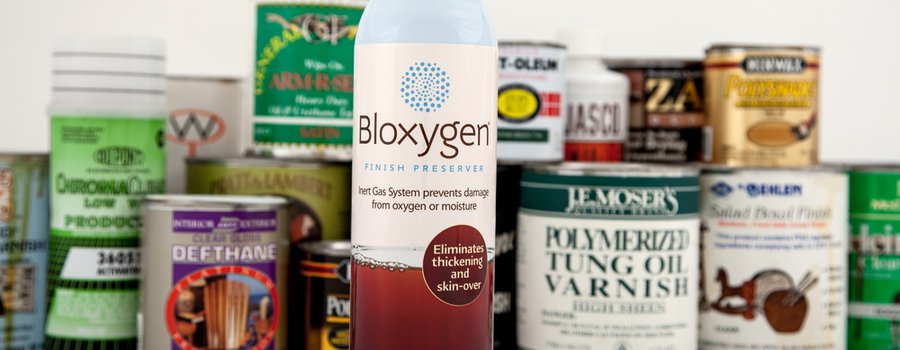As a wood finishing products retailer, we often get calls and emails from customers asking us if their leftovers from a product purchased 2, 5, or 10 years ago can still be used for a finishing project. The answers vary, since finishing products are made from different components, some of which may be sensitive to oxidation, moisture, light and temperature variations, and some which are impervious to these external factors. Anyone who had to throw away leftovers from a gallon of oil based paint or stain that has skinned, thickened or turned to gel knows how irritating and expensive it can be. Environmental costs must also be taken into account, as they are not negligible. Luckily, there are several ways to extend the shelf life of these sensitive leftovers, and even eliminate oxidation issues altogether. Read on to understand why leftovers go bad, and what you can do to prevent it.
Why do some finishing products deteriorate over time?
Many factors can lead to chemical degradation over time and leave your leftovers unusable. Some are easy to control, others, less:
-
Exposure to light: Some products are sensitive to light, which can cause chemical changes and alter the product's properties, making it less effective or completely ruining it. Avoiding this problem is easy by making sure you use opaque containers for your leftovers.
-
Freeze and heat: Some products are sensitive to freezing, heat, or temperature variations. In some cases, a product can tolerate a maximum number of freezing/thawing cycles before it goes bad. High temperatures can also alter the molecular structure of chemical products, which can reduce their efficiency. Finishing products should always be stored in a cool, dry place, away from heat sources and the sun. Also avoid leaving them in a vehicle where they can be subjected to heat or cold, or in a non-heated garage or shed during winter.
-
Oxidation : This is the most difficult factor to control. Any product sensitive to oxidation will see its shelf life diminish significantly if no measure is taken to protect it against exposure to ambient air.
The speed at which a product will deteriorate will depend on its ingredients as well as its level of exposure to the different elements described above: Light, Freeze, Heat, and oxidation. A product that has deteriorated might thicken, gellify, or form a skin on the surface. It can also form sediments which can block or jam HVLP or conventional spray guns, all of these potentially leading you to unknowingly sabotage your finishing coat.
Using a leftover that has deteriorated over time is a gamble: Oxidized oil, for example, might not polymerize (dry) fully after application, which will be costly in terms of time and money, to strip/sand and finish again with a new gallon. There are also environmental costs to this waste of chemical products, which are not negligible: In the US, for example, according the the EPA, more than 40 million litres of oil based paint go to waste every year...
Which finishing products are perishable?
Good news, Canada: Less and less finishing products in Canada are sensitive to oxidation, as recent changes to environmental laws concerning VOCs (Volatile Organic Compounds) lead to the removal of several oil based products which were very sensitive to oxidation. Similar laws have been established in the European Union. The United States is less restrictive at the moment, so you can find a much wider choice of oil and solvent based paints, stains and varnishes. These products are slowly being replaced by water based products, which are more chemically stable and are not vulnerable to oxidation. However, there are still many finishing products on the market that can turn bad if they are not stored properly, whether you're based in Canada, USA or the EU:
-
Any urethane or polyurethane based product (General Finishes, Old Master and several industrial brands such as Can Lak, Chemcraft, Akzo Nobel, Sico Industrial, etc.);
-
Urethane Glues (DuraPro, Titebond, Gorilla Glue, etc.*);
-
Finishing Oils (Livos, Tried & True, Old Master, Deft, Minwax, Circa, Prato-Verde, Watco, Carver, etc.);
-
Marine Varnishes and other oil based varnishes (Epifanes, Interlux, Behr, etc.);
-
Epoxy resin (Varathane, Circa, West Coat, East Coat, etc.);
-
Oil based paints and stains (Deft, Varathane, Tremclad, Minwax, Old Master, General Finishes, etc.).
How to minimize oxidation ?
There are many tricks of the trade which will allow you to extend the shelf life of your finishing products by minimizing oxidation as much as possible. Here's a short list of best practices... and things to avoid:
-
Transfill : Pour your leftovers in the smallest container you can find to minimize the oxygen remaining in the head space. This will minimize oxidation, but it can still happen as long as oxygen is in direct contact with the product. Make sure that you are using an opaque container to avoid degradation due to exposure to light.
-
Airproof container : It's very important to have a sealed can when you store your leftovers. To make sure it is airproof, the groove on your can must be clean so the lid can be sealed properly. The best way to do this is to use a plastic spout over the can or gallon to prevent any paint from drying in the groove. This has the added benefit of preventing any product spill. Some people like to use a plastic wrap between the lid and the can. It can be done, but you need to make sure that it does not prevent your lid to seal completely. Otherwise, it'll just make things worse.
-
DON'T : drill small holes in the groove to allow the liquid to drain back into the can. This is not recommended: Any alteration to the can might compromise the seal, and you'll be worse off. The groove and lid is a very simple system to create a good seal. Any dented can or bent seal might not allow a proper seal, so it's always a good idea to put the leftovers in a new can.
-
DON'T : use a disc of wax paper over the leftovers in the can. It doesn't work. Oxygen still gets through, the product will stick to the wax paper and will form a film or crust over time.
-
DON'T : Use rocks, marbles or other objects to fill the can in order to minimize the volume of oxygen: Other than being a very messy process, this raises the risk of product contamination. Furthermore, there will still be air in the can, directly in contact with your leftovers. You'd better transfill in a smaller container. But there is a much better solution...
Preventing oxidation altogether? It's possible with a Finishing Product Preserver!
The tips above will certainly help you to minimize oxidation, but the fact is that there will always remain oxygen in contact with your leftovers, slowly but surely leading to its chemical degradation over time. That's fine if you plan on using your leftovers in a short time span, but what if you don't know when you'll use them again, and need to store them for several months or years? Here's how to eliminate the risk of oxidation altogether.

A simple and economical solution to prevent any risk of oxidation, saving you both time and money while reducing waste, is to use a Finishing product preserver, such as Bloxygen. It is an inert gas, usually argon, which is 25% heavier than oxygen. CO2 (Carbon dioxide) reacts with water to create carbonic acid, and air dusters contain difluoroethane, a flammable gas. Argon cannot burn, explode or react with different chemical products. By spraying a small quantity of argon in your can right before sealing the lid, it will displace oxygen and drop to the surface of your leftovers, forming a shield between oxygen and your finishing product, thus effectively preventing oxidation.
For around 15 dollars, a pressurized argon bottle will allow for approximately 75 uses in a quart, so the bottle should last several years and allow for significant savings. Considering that a single use of Bloxygen can prevent wasting half of a quart of marine varnish, which can cost anywhere between $50-75, saving only a quarter of a quart already pays for the cost of Bloxygen. The 74 other uses are "free"! Furthermore, you can save even more money by purchasing gallons instead of quarts, which are usually a better deal, since you now have a tool to extend their shelf life indefinitely.
Bloxygen, a product not limited to finishing products!

Bloxygen prevents oxidation in general. Consequently, its pure, inert argon can be used for several applications other than preserving finishing products, such as extending the shelf life of gunpowder, printing supplies, laboratory chemicals, auto body products, and fuel additives. However, it is important to note that argon has very little or no effect on water based products, which are not sensitive to oxidation. It is only useful for urethane, polyurethane and oil based products, as well as epoxy resins.
Oxidation can also ruin some food products. Would you like to preserve your half-finished wine bottle, but you don't have a vacuum system around? Want to prevent your fresh guacamole, potatoes, bananas and shrimp for turning brown, or want to make sure your fresh coffee beans won't go stale? Try Bloxygen, you might be surprised... A Bloxygen customer recently told the company that he's been using the product for 10 years to preserve his single Malt collection, and that it keeps his scotch as fresh as the day he opened each bottle!
Are you aware of any oxygen sensitive product not mentioned in this article for which Bloxygen could be useful? Let us know in the comments section below!







